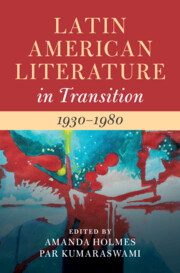Book contents
- Latin American Literature in Transition 1930–1980
- Latin American Literature in Transition
- Latin American Literature in Transition 1930–1980
- Copyright page
- Contents
- Contributors
- Introduction
- Part I War, Revolution, Dictatorship
- Part II Metropolis and Ruins
- Part III Solidarity
- Part IV Aesthetics and Innovation
- Index
Chapter 14 - Eros: After Surrealism and Before the Revolution (1945–1967)
from Part IV - Aesthetics and Innovation
Published online by Cambridge University Press: 24 January 2023
- Latin American Literature in Transition 1930–1980
- Latin American Literature in Transition
- Latin American Literature in Transition 1930–1980
- Copyright page
- Contents
- Contributors
- Introduction
- Part I War, Revolution, Dictatorship
- Part II Metropolis and Ruins
- Part III Solidarity
- Part IV Aesthetics and Innovation
- Index
Summary
The most provocative legacy of surrealism in Latin America in the period following World War II can arguably be found in the work of women artists and writers. The postwar feminine surrealisms examined in this chapter responded to the encroachment of capitalism in daily life and the gradual, if incomplete, loosening of normative categories of sex and gender. Taking up historical surrealism’s focus on eros as an incomplete promise, they expanded into alternative configurations of sex, desire, and family life, while simultaneously emphasizing persistent, if updated, forms of gendered violence. This chapter analyzes experimental writers and visual artists from Brazil, Argentina, and Uruguay from the mid-1940s to the mid-1960s – Grete Stern, Maria Martins, Marosa Di Giorgio, and Alejandra Pizarnik. It concludes by noting the legacies of their erotic surrealisms for contemporary art and literature.
- Type
- Chapter
- Information
- Latin American Literature in Transition 1930–1980 , pp. 229 - 244Publisher: Cambridge University PressPrint publication year: 2022

